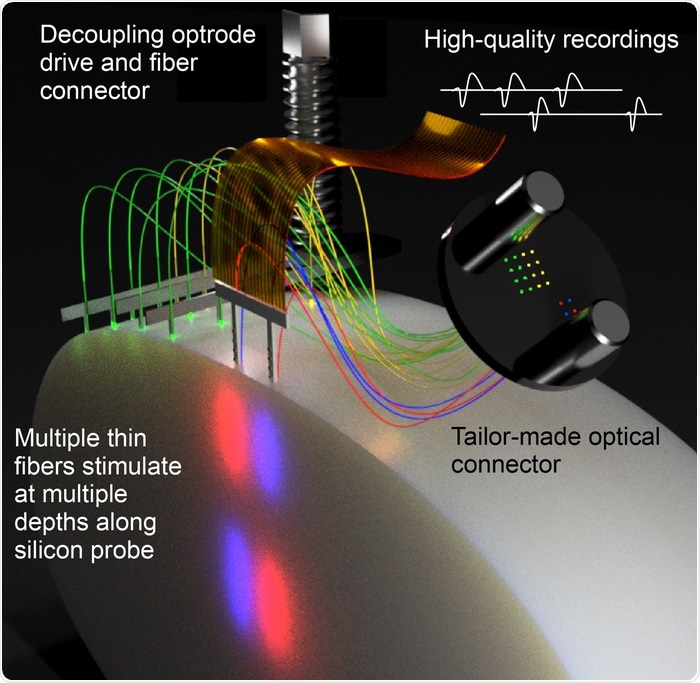A new approach for regulated interrogation and recording of neuronal activity was developed by scientists at the University of Freiburg.

Scheme of the new Fused Fiber Light Emission and eXtracellular Recording (FFLEXR). Image Credit: Research group Ilka Diester.
In the optogenetics field, researchers examine the neurons’ activity in the brain with light. A research team headed by Prof. Dr Ilka Diester and Dr David Eriksson from the Optophysiology Laboratory at the University of Freiburg has demonstrated a novel approach to conduct multifiber stimulations, laminar recordings, connectivity inference, 3D optogenetic stimulation, and behavioral quantification on brains simultaneously.
Their findings are published in Nature Communications.
Our work paves the way for large-scale photo-recording and controlled interrogation of fast neural communication in any combination of brain areas. This can help us unravel the rapid and multilayered dialogues between neurons that maintain brain function.”
Dr Ilka Diester, Professor, Optophysiology Laboratory, University of Freiburg
The team, in collaboration with Dr Patrick Ruther of the Department of Microsystems Engineering (IMTEK) from the University of Freiburg, is devising a new technique for the recording of neuronal activity and controlled interrogation in the brain. To execute this, the research group is taking the benefit of thin, cell-sized optical fibers for negligibly invasive optogenetic implantation.
“We combine side-emitting fibers with silicon probes to achieve high-quality recordings and ultrafast, multichannel optogenetic control,” the researchers stated.
Researchers call the system Fused Fiber Light Emission and eXtracellular Recording, or FFLEXR. Alongside optical fibers that can stick to any silicon probe, the team uses linear depth-resolved stimulation, a flexible multifiber ribbon cable, a lightweight fiber matrix connector, a general-purpose patch cable, an optical commutator for efficient multichannel stimulation, and an algorithm to manage the photovoltaic response.
Our alternative approach maintains the flexibility to apply any desired wavelength via an external interchangeable light source and enable optogenetic stimulation at different depths of brain tissue.”
Dr Ilka Diester, Professor, Optophysiology Laboratory, University of Freiburg
Dr Ilka Diester leads a research team—at the Institute of Biology III and research center IMBIT/BrainLinks-BrainTools at the University of Freiburg—that uses optophysiology, that is, new optical tools, to examine the operation of neuronal circuits.
The scientists are examining the neuronal basis of cognitive and motor control as well as interactions between the motor and prefrontal cortex—both of them are part of the cerebral cortex.
Source:
Journal reference:
Eriksson, D., et al. (2022) Multichannel optogenetics combined with laminar recordings for ultra-controlled neuronal interrogation. Nature Communications. doi.org/10.1038/s41467-022-28629-6.